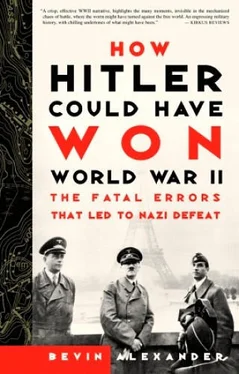On March 19, Rommel flew to Hitler’s headquarters to get fresh instructions. Walther von Brauchitsch, commander in chief of the army, and Franz Halder, chief of staff, told Rommel there was no intention of striking a decisive blow in Africa, and he could expect no reinforcements.
Rommel tried to convince them that the weakness of the British in North Africa should be exploited. But his pleas fell on deaf ears. Brauchitsch and Halder were preoccupied with preparations for Barbarossa and distracted by the campaign against Greece about to commence. To them, Libya was a sideshow to a sideshow.
Rommel wanted two additional panzer divisions to complete conquest of Egypt. It was obvious that transporting them to Tripoli was the key problem, and to solve it Malta had to be neutralized by severe bombing attacks or seized in an air-sea operation. But Halder chose to ignore this unmistakable fact and asked Rommel how two additional divisions could be maintained and supplied. Rommel, exasperated, replied: “I don’t give a damn. That’s your affair!”
Back in Africa, Rommel sent his reconnaissance battalion to seize El Agheila on March 24. The small British force put up little fight, and withdrew to Mersa el Brega, twenty miles east. This was a potentially formidable position. Mersa el Brega was on a commanding height near the sea, while to the south was the Bir es Suera salt marsh, and south of the marsh was the extensive, sandy Wadi Faregh. Both were almost impassable for vehicles.
Rommel could wait for the rest of his troops to arrive at the end of May, or attack with the small force he had in place. For him the decision was easy: attack. If he waited, the British would have time to build a powerful defensive line.
When elements of 5th Light Division struck on March 31, the British hurled them back. In the afternoon Rommel found a way around the British between the Via Balbia and the sea. That night 8th Machine Gun Battalion’s vehicles crashed through the gap in a headlong rolling attack, flanked the British, and caused them to beat a hasty retreat, leaving behind fifty Bren gun-carriers and thirty lorries.
Luftwaffe reports showed that the British were pulling back from Agedabia. It was an opportunity Rommel couldn’t resist. He at once ordered his forces to advance on Agedabia, gaining it on April 2.
Neame, with Wavell’s permission, decided to evacuate Benghazi and retreat eastward. The abrupt withdrawal was a bonanza for Rommel, and he rushed to exploit it.
“I decided to stay on the heels of the retreating enemy, and make a bid to seize the whole of Cyrenaica at one stroke,” Rommel wrote.
Now commenced one of the most dramatic running battles in world history, in which an inferior force attacked and completely routed a superior enemy. Rommel ordered the reconnaissance battalion to drive straight toward Benghazi on the Via Balbia behind the retreating British, while Ariete Division’s reconnaissance battalion was to rush across the chord of the Cyrenaican bulge to get to the sea and cut off retreat before the British arrived.
Rommel made the decision to cut through the Cyrenaican interior despite warnings from Italian generals that the route was a death trap. Rommel examined the country by air, found it good for driving, and the Italians’ fears baseless.
Rommel learned that the British had already abandoned Benghazi, and at once ordered the 3rd Reconnaissance Battalion to drive into the town. It arrived on the night of April 3.
On the morning of April 4, Rommel directed the main body of 5th Light Division to move through Ben Gania and on to the sea at Derna, while Ariete Division following the same route turned north to seize El Mechili, south of Jebel el Akdar, the mountain range along the coast. Speed was now everything. Rommel wanted to bring at least part of the British army to battle before it withdrew from Cyrenaica and escaped danger.
During the night, Rommel learned that British forces were still holding Msus, about seventy miles southeast of Benghazi and fifty miles northwest of Ben Gania. He also learned that the best route for his supply trucks was through Msus.
On the morning of April 5, Rommel ordered most of his armor—5th Panzer Regiment and forty Italian tanks—to head straight for Msus, destroy the enemy there, and press on to Mechili. Though held up by sandstorms, the tanks took Msus on the evening of April 6, but got lost on the way to Mechili, moved far to the north, and were only discovered by Rommel flying in his light Storch reconnaissance plane on the evening of April 7.
Meanwhile, a newly arrived British motorized brigade had occupied Mechili. While Rommel sent a small force to the sea at Derna to close the Via Balbia in both directions, he sent his main force from east and west against the British brigade at Mechili on April 8, forcing its surrender. He then rushed tanks on to Derna, where German forces captured many more prisoners, including General Neame and General O’Connor, who had come back from Egypt to assist Neame. Their unescorted car had run into Germans on the Via Balbia.
By April 11, 1941, the British had been swept entirely out of Cyrenaica and over the frontier into Egypt, except for two divisions that shut themselves up in the port of Tobruk, which the Italians had built into a fortress before the war, and which the Royal Navy could supply by sea.
Rommel had won by deceiving the British into believing his forces were much stronger than they were, and he moved with great speed, bewildering the British and causing their forces to disintegrate.
Rommel had too little power to undertake a heavy assault against Tobruk, yet he insisted on mounting several attacks, all of which failed against the resolute Australian and British garrison.
The date of Rommel’s eviction of the British from Libya, except Tobruk, is significant. The campaign against Yugoslavia and Greece had been launched on April 6, and German forces were already scoring decisive successes, indicating that the campaign would soon be completed.
Rommel had handed Hitler an entirely unexpected victory that left the Africa Corps poised within striking distance of the Suez Canal. All that would now be required to win Egypt would be the swift transfer, as soon as the Greek campaign ended, of two panzer divisions to reinforce Rommel. The British were reeling from defeats in Greece and Libya, and could not have withstood a concerted attack.
The garrison at Tobruk could have been blocked by Italian divisions, braced by a few German tanks. With an offensive launched against the Egyptian delta, the British could not have mounted an offensive from that fortress.
Admiral Raeder and the naval staff recognized what Rommel had achieved, and proposed to Hitler “a decisive Egypt-Suez offensive.” If Rommel had been reinforced, he almost surely would have occupied Egypt long before the end of 1941.
Unfortunately for the Germans, none of this happened. Hitler didn’t recognize the gift that Rommel had handed him and turned his gaze once more on the Soviet Union.
In his appraisal of his first campaign, Rommel came to virtually the same conclusions that Admiral Raeder had reached half a year previously.
“It is my view,” he wrote, “that it would have been better if we had kept our hands off Greece altogether, and rather created a concentration of strength in North Africa to drive the British right out of the Mediterranean area.”
The air forces employed in Greece should have been used to protect convoys to Africa, he added. Malta should have been taken instead of Crete. Powerful German motorized forces in North Africa could then have seized the whole of the British-occupied Mediterranean coastline, as well as the Middle East as sources for oil and bases for attack on Russia.
“This would have isolated southeastern Europe. Greece, Yugoslavia, and Crete would have had no choice but to submit, for supplies and support from the British Empire would have been impossible.”
Читать дальше


![Джонатан Димблби - Barbarossa - How Hitler Lost the War [calibre]](/books/385421/dzhonatan-dimblbi-barbarossa-how-hitler-lost-the-w-thumb.webp)









